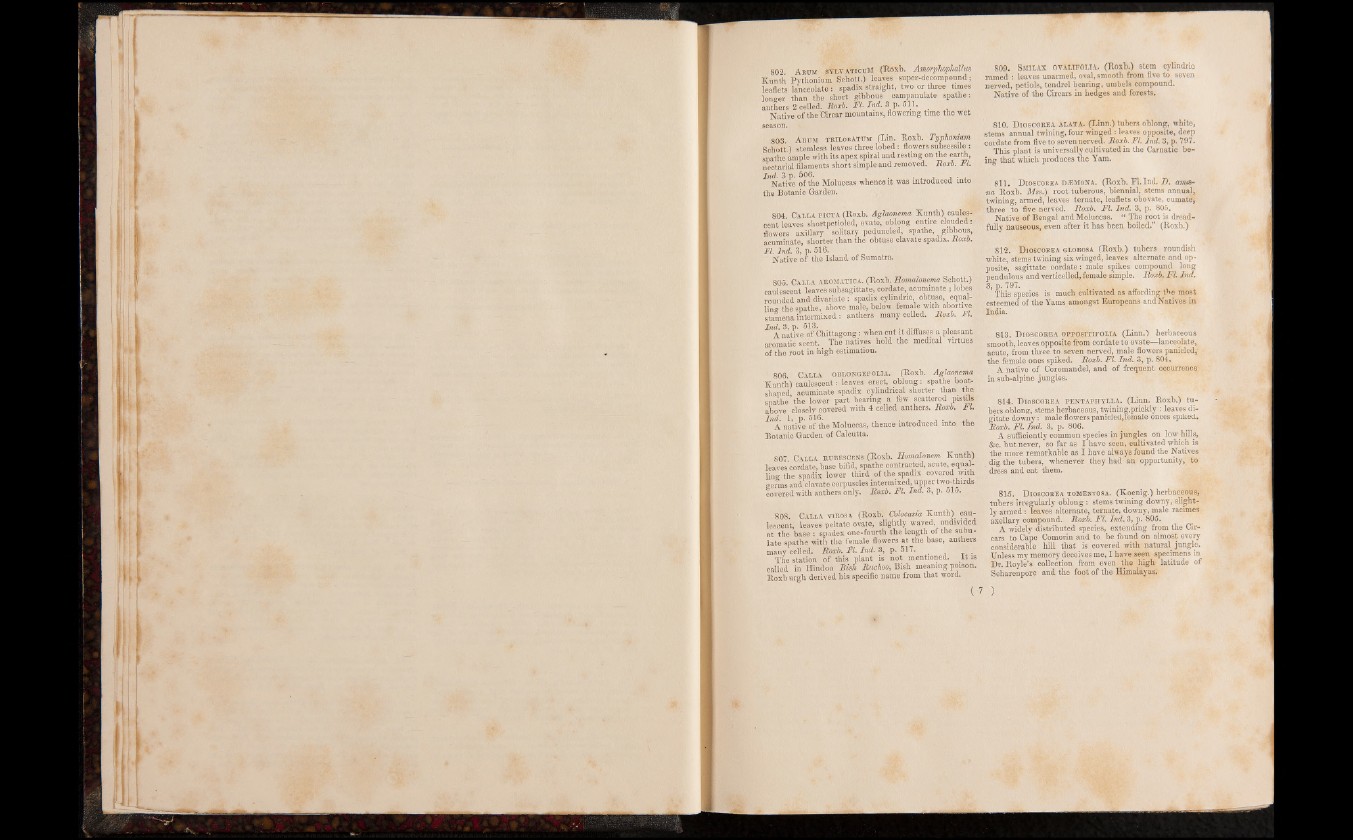
802 Arum sylvaticum (Boxb. AmorphopMlus
Kunth Pythonium Schott.) leaves super-decompeund;
leaflets lanceolate : spadix straight, two or three times
longer than the short gibbous campanulate spathe:
anthers 2 celled. Boxb. FL Ind. 3 p. 511. _
Native of the 'Oircar mountains, flowering time the wet
.season.
803. Aeum tbilobATUm (Lin. Roxb. TypJionium
Schott.) stemless leaves three lobed: flowers subsessile :
spathe ample with its apex spiral and resting on the earth,
nectarial filaments short simple and removed. Roxb. FI.
Ind. 3 p. 506. . . , , , . ,
Native of the Moluccas whence it was introduced into
the Botanic Garden.
804. Calla PICTA (Roxb. Aglaonema Kunth) caulescent
leaves shortpetioled, ovate, oblong entire clouded : : -
flowers axillary solitary peduncled, spathe, gibbous,
acuminate, shorter than the obtuse clavate spadix. Roxb.
' Fl. Ind. 3, p- 516.
- Native of the Island of Sumatra.
805. Calla abomatica. (Roxb. Homalonema Schott.)
caulescent leaves subsagittate, cordate, acuminate ; lobes
rounded and divariate : spadix cylindric, obtuse, equalling
the spathe, above male, below female with abortive
stamena intermixed : anthers many celled. Roxb. Fl.
^ A native of Chittagong: when cut it diffuses a pleasant
aromatic scent. The natives hold the medical virtues
of the root in high estimation.
806. Calla oblongefqlia. (Roxb. Aglaonema
Kunth) caulescent: leaves erect, oblong: spathe boatshaped,
acuminate spadix cylindrical shorter than the
spathe the lower part bearing a few scattered pistils
above closely covered with 4 celled anthers. Roxb. Fl.
Ind. 1, p. 516. . , , . ,,
A native of the Moluccas, thence introduced into the
Botanic Garden of Calcutta.
807 Calla btjbescens (Roxb. Homalonem Kunth)
leaves cordate, base bifid, spathe contracted, acute, equal-
liug the spadix lower third of the spadix covered with
germs and clavate corpuscles intermixed, upper two-thirds
covered with anthers only. Roxb. Fl. Ind. 3, p. 515.
808. Calla viBosa (Roxb. Colocasia Kunth) caulescent,
leaves peltate ovate, slightly waved, undivided
at the base : spadex one-fourth the length of the subulate
spathe with the female flowers at the base, anthers
many celled. Roxb. Fl. Ind. 3, p. 517. _
The station of this plant is not mentioned. _lt is
called in Hindoo Bish Ruchoo, Bish meaning poison.
Roxburgh derived his specific name from that word.
809. Smilax OVAL1FOLIA. (Roxb.) stem cylindric
ramed : leaves unarmed, oval, smooth from five to seven
nerved, petiols, tendrel bearing, umbels compound.
Native of the Circars in hedges and forests.
810. Dioscobea ALATA. (Linn.) tubers oblong, white,
stems annual twining, four winged : leaves opposite, deep
cordate from five to seven nerved. Roxb. Fl. Ind. 3, p. 797.
This plant is universally cultivated in the Carnatic being
that which- produces the Yam.
811. Dioscorea djjmona. (Roxb. Fl. Ind. D. ama-
na Roxb. Mss.) root tuberous, biennial, stems annual,
twining, armed, leaves temate, leaflets obovate, cumate,
three to five nerved. Roxb. Fl. Ind. 3, p. 805.
Native of Bengal and Moluccas. “ The root is dreadfully
nauseous, even after it has been boiled.” (Roxb.)
812. Dioscobea globosa (Roxb.) tubers roundish
white, stems twining six winged, leaves alternate and opposite,
sagittate cordate: male spikes compound long
pendulous and verticelled, female simple. Roxb. Fl. Ind.
3, p. 797. ; .
This species is much cultivated as affording the most
esteemed of the Yams amongst Europeans and Natives in
India.
813. Dioscobea oppositifolia (Linn.) herbaceous
smooth, leaves opposite from cordate to ovate—lanceolate,
acute, from three to seven nerved, male flowers panicled,-
the female ones spiked. Roxb. Fl. Ind. 3, p. 804.
A native of Coromandel, and of frequent occurrence
in sub-alpine jungles.
814. Dioscobea pentaphylla. (Linn. Roxb.) tubers
oblong, stems herbaceous, twining,prickly : leaves digitate
downy: male flowers panicled,female onces spiked.
Roxb. Fl. Ind. 3, p. 806.
A sufficiently common species in jungles on low hills,
&c. but never, so far as I have seen, cultivated which is
the more remarkable as I have always found the Natives
dig. the tubers, whenever they had an opportunity, to
dress and eat them.
815. Dioscobea tomentosa. (Koenig.) herbaceous,
tubers irregularly oblong: stems twining downy, slightly
armed: leaves alternate, ternate, downy, male racimes
axellary compound. Roxb. Fl. Ind. 3, p. 805.
A widely distributed species, extending from the Circars
to Cape Comorin and to be found on almost every
considerable hill that is covered with natural jungle.
Unless my memory deceives me, I have seen specimens in
Dr. Royle’s collection from even the high latitude of
Seharenpore and the foot of the Himalayas.
( 7 )